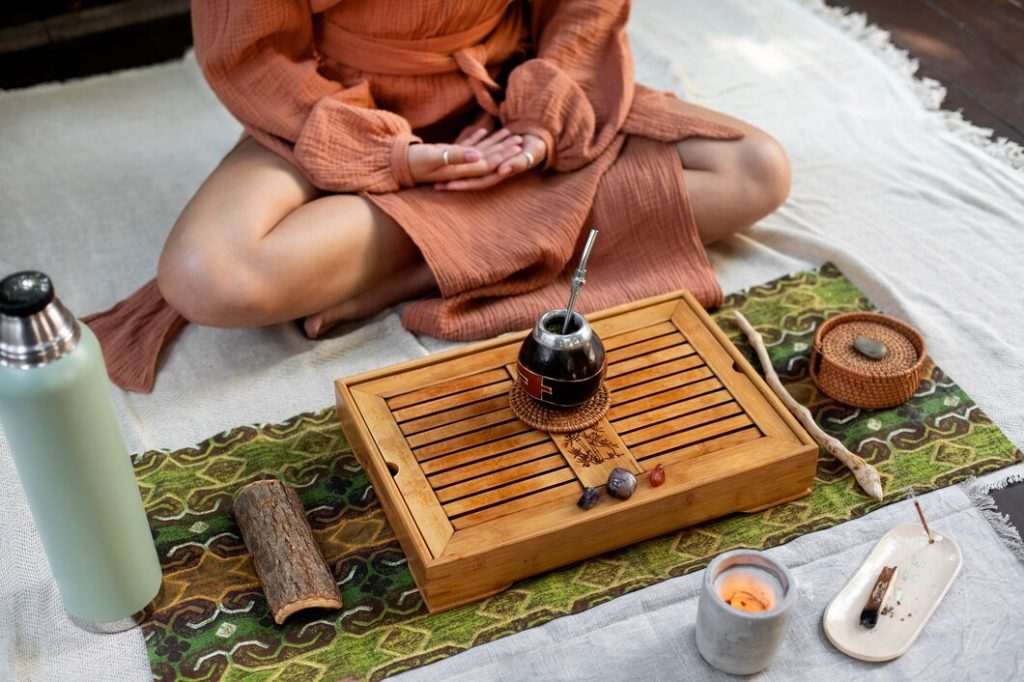In the intricate dance of life, relationships play a central role. Whether personal, familial, romantic, or professional, relationships shape our daily experience and often reflect our inner state. In Ayurveda, an ancient system of healing that focuses on balance in body, mind, and spirit, relationships are viewed as a mirror of our internal health. By addressing our inner world and making conscious efforts to align ourselves with our true nature, we can create more harmonious, loving, and fulfilling connections with others. This article explores how relationships work, the importance of cultivating a healthy relationship with oneself, and how Ayurveda’s wisdom can guide us in building healthier, more balanced relationships.
The Role of the Mind and Self-Awareness in Relationships
In Ayurveda, the qualities of the mind—known as gunas—play a vital role in how we relate to others and ourselves. Understanding these qualities—sattva (clarity and harmony), rajas (activity and agitation), and tamas (inertia and ignorance)—is key to cultivating meaningful connections.
A sattvic mind fosters calmness, compassion, and wisdom, creating fertile ground for thriving relationships. When sattva predominates in our mind, communication is empathetic and thoughtful, free from judgment or impulsivity, offering constructive feedback. Conversely, when rajas takes over, the mind becomes restless, competitive, or overly driven, leading to conflict, impatience, or a tendency to dominate. This can make relationships feel strained or reactive with impatience or sharp words. On the other hand, tamas manifests as lethargy, resistance to change, or emotional withdrawal, often resulting in misunderstandings, shutting down, avoiding conversation or apathy that create distance between individuals.
Before we can connect harmoniously with others, Ayurveda emphasizes the need for self-awareness. Observing our thoughts, emotions, and behaviors without judgment is the first step toward uncovering the patterns that shape our relationships. By cultivating sattva through mindfulness, reflection, and self-care, we can bring clarity and harmony into our interactions. This doesn’t mean eradicating rajas or tamas—both have their place—but finding a balance where sattva guides us toward understanding, forgiveness, and love.
Self-awareness is not a one-time realization but a continual process. Every interaction offers an opportunity to pause, reflect, and adjust, not to dwell on faults but to uncover the roots of disharmony and nurture personal growth. By balancing the gunas within, we create the foundation for deeper, healthier connections with others.
The Doshas and Relationship Dynamics
Ayurveda identifies three doshas—Vata, Pitta, and Kapha—as the forces that govern our physical and emotional tendencies. These doshas influence how we relate to others:
- Vata (Air and Space): Creative, expressive, and enthusiastic, Vata types are great communicators. But when out of balance, they may struggle with anxiety, inconsistency, or overthinking, which can lead to misunderstandings or emotional withdrawal.
- Pitta (Fire and Water): Driven, passionate, and confident, Pitta types are natural leaders. However, an imbalanced Pitta can become impatient, critical, or controlling, causing friction in relationships.
- Kapha (Earth and Water): Loyal, nurturing, and stable, Kapha types bring warmth and support to relationships. Yet, when imbalanced, they may become overly attached, resistant to change, or emotionally stagnant.
By observing these tendencies, you can begin to identify patterns in your interactions. Do you avoid confrontation? Overreact to criticism? Struggle to set boundaries? Inner reflection helps you see these patterns clearly and offers a starting point for transformation.
Additionally, understanding the dosha of others can help foster empathy. A Pitta person’s need for precision isn’t a criticism; it’s their way of expressing care. A Kapha friend’s hesitation to try new things isn’t stubbornness; it’s their need for stability. Recognizing these individual traits deepens mutual respect and allows us to embrace the diversity within our relationships.
One crucial aspect of fostering balanced relationships is understanding and managing expectations. Ayurveda teaches us that many of our expectations stem from desires, which are sometimes driven by imbalances in the mind or body. When these expectations go unspoken or are unrealistic, they can lead to frustration and disappointment. A key Ayurvedic principle, svadharma—our personal path or purpose—helps us align our expectations with our true nature. By doing so, we cultivate more realistic hopes and greater acceptance of ourselves and others. Each person brings unique qualities shaped by their dosha, influencing how they express love, handle challenges, and meet emotional needs. By honoring these differences, we can release unrealistic expectations, fostering mutual respect and understanding in our relationships..
Inner Reflection Practices for Better Relationships
Inner reflection helps us identify the emotions, habits, and mindsets that shape our relationships. Ayurveda offers practical tools to nurture this awareness and create a foundation of balance:
1. Meditation for Emotional Clarity
Meditation calms the mind, helping us observe our thoughts and feelings without being overwhelmed by them. This practice is especially helpful for cultivating sattva, the quality of clarity and harmony.
- For Vata imbalances (restlessness or fear), grounding meditations focused on the breath can bring calm and stability.
- For Pitta imbalances (irritability or anger), visualizations of cooling imagery, like flowing water, can soothe the mind.
- For Kapha imbalances (apathy or attachment), energizing meditations that focus on gratitude or motivation can reignite a sense of purpose.
2. Journaling for Self-Awareness
Writing down your thoughts and emotions is a powerful way to uncover hidden patterns. Regular journaling can reveal recurring fears, unmet needs, or unhelpful habits that influence your relationships.
Questions to reflect on include:
- What am I seeking in my relationships?
- How do I react when conflicts arise?
- Am I showing the same compassion to others that I show to myself?
3. Breathwork for Emotional Release
Unresolved emotions often create tension in relationships. Ayurvedic breathing techniques (pranayama) help release these emotional blockages.
- Alternate nostril breathing (Nadi Shodhana) balances the mind and emotions, fostering calm interactions.
- Sitali breath cools heated emotions like anger or frustration.
- Kapalabhati energizes and uplifts when feelings of heaviness or stagnation arise.
Outer Connection: Nurturing Relationships Through Balance
When we cultivate inner balance, it naturally extends to our relationships. Ayurveda provides simple yet profound guidance for nurturing connections with others:
1. Communicate Mindfully
Mindful communication involves listening deeply and expressing yourself with clarity and compassion. Ayurveda reminds us to pause before responding, allowing us to choose words that reflect our true intentions.
2. Honor Individual Differences
Just as each dosha has its unique strengths, so do the people in our lives. Rather than trying to change others, celebrate their unique qualities and adapt to their needs.
3. Build Shared Rituals
Shared experiences strengthen bonds. Whether it’s cooking together, enjoying a morning walk, practicing yoga, or ending the day with a gratitude practice, where each person shares something they are grateful for about the others. These rituals create meaningful moments of connection.
4. Practice Forgiveness
Holding onto grudges or past hurts creates energetic blockages that strain relationships. Forgiveness doesn’t mean forgetting—it means freeing yourself from the weight of negativity and choosing peace over resentment.
5. Set Healthy Boundaries
Boundaries protect your energy and maintain mutual respect. Ayurveda encourages you to reflect on your needs and communicate them clearly to others. For example:
- A Vata person might need more consistency and reassurance.
- A Pitta individual might require space and independence.
- A Kapha type may benefit from encouragement to step outside their comfort zone.
Resolving Conflict: the Ayurvedic Way
Conflict is a natural part of any relationship, but how we approach it makes all the difference. Ayurveda offers guidance for resolving conflicts with balance and grace:
- Stay Grounded: When emotions run high, grounding techniques like slow breathing or stepping away for a moment can help you regain clarity.
- Seek Understanding: Ayurveda emphasizes empathy. Try to see the situation from the other person’s perspective before reacting.
- Focus on Growth: Every conflict is an opportunity to learn—about yourself, the other person, and the relationship itself.
The STOP technique—Stop, Take a breath, Observe, and Proceed—, a modern mindfulness helps us pause and recalibrate during moments of heightened emotion, aligning beautifully with Ayurveda’s focus on self-awareness and intentionality.
- Stop: When faced with a challenging interaction, simply pause. This moment of stillness is akin to grounding yourself, a practice Ayurveda often recommends to pacify aggravated Vata (the dosha of movement and restlessness). By stopping, you prevent impulsive reactions and give yourself space to respond mindfully.
- Take a Breath: Breathing is central in Ayurveda as a tool to balance the mind and emotions. Taking a deep, intentional breath calms an overactive Pitta (irritability) and clears emotional clouds from an imbalanced Kapha (stagnation).
- Observe: Reflect on what’s happening inside and around you. What emotions are arising? Are you reacting from a place of fear, anger, or frustration? Observation aligns with Ayurveda’s principle of cultivating sattva by fostering awareness of the gunas and doshas influencing your state. Ask yourself: Am I grounded and clear, or am I letting rajas or tamas dictate my reaction?
- Proceed: After grounding yourself, move forward with intentionality. A sattvic approach to proceeding might involve communicating with kindness, setting healthy boundaries, or practicing forgiveness. This step embodies Ayurveda’s guidance to respond, not react, and to prioritize harmony in your interactions.
The Ayurvedic Ripple Effect
Ayurveda teaches that when we cultivate balance within, it creates a ripple effect that transforms our external world. By nurturing a sattvic mind, healing emotional imbalances, and approaching relationships with mindfulness, we align our inner reflection with outer connection.
When you commit to this journey, you’ll notice profound changes—not just in your relationships with others but also in your relationship with yourself. Compassion replaces criticism, understanding replaces conflict, and connection replaces distance.
Relationships, after all, are an extension of how we relate to ourselves. By tending to our inner world, we create the space for love, harmony, and joy to flourish—both within and around us.




